Nepal, a nation often whispered about in legends and revered for its towering Himalayan peaks, has long held an aura of mystique. For years, its relative isolation only amplified its allure for adventurers and spiritual seekers. Some even believe that the Kathmandu Valley in Nepal inspired the mythical paradise of “Shangri-La” in James Hilton’s 1933 novel, Lost Horizon. Today, Kathmandu is widely recognized as the vibrant capital of the Federal Democratic Republic of Nepal. However, the name “Kathmandu” extends beyond the city limits, encompassing a sprawling region nestled within a basin-shaped valley.
Delving into the Meaning of Kathmandu
The name Kathmandu resonates with the local Pahari people, who constitute a significant portion of the population. It’s widely accepted that the name originates from the iconic Kasthamandap Temple, a remarkable three-tiered pagoda that once graced Durbar Square in the city. “Kastha” translates to “wood,” and “mandap” signifies a covered shelter or pavilion. Thus, Kasthamandap literally means “wooden shelter.” Interestingly, in certain Buddhist texts, Kasthamandap is still used as an alternative name for the city itself, highlighting the temple’s profound cultural and historical significance. While tradition dates the Kasthamandap Temple to the 16th century, archaeological discoveries suggest an earlier structure existed on the same site as far back as the 7th century. Tragically, the temple succumbed to the devastating earthquake of 2015. Yet, hopes remain high for its restoration to its former splendor, a testament to its enduring importance.
Pinpointing Kathmandu’s Location
Kathmandu, the bustling metropolitan city, lies within the Kathmandu Valley, situated in the Central District of Nepal. Nepal itself is a landlocked, mountainous country cradled in the heart of Asia, wedged between the vast expanse of Tibet (China) to the north and India to the south. This strategic location places Kathmandu at the crossroads of ancient cultures and trade routes. For those seeking to conquer the world’s highest peak, Mount Everest, Kathmandu serves as a crucial stepping stone, located approximately 100 kilometers (62 miles) to the east and slightly north of the city. This entire region is often considered the gateway to the majestic Himalayas, offering breathtaking views and access to some of the world’s most challenging trekking routes. Kathmandu sits at a considerable elevation of around 1,400 meters (4,600 feet) above sea level, contributing to its unique climate and atmosphere.
 Map showing the location of Kathmandu in Nepal, nestled in the Himalayan mountains between India and Tibet.
Map showing the location of Kathmandu in Nepal, nestled in the Himalayan mountains between India and Tibet.
Understanding Kathmandu’s Climate
The climate of Kathmandu often surprises first-time visitors. Despite its high altitude and inland continental position, Kathmandu enjoys a “warm temperate” climate. While microclimates exist due to variations in altitude and topography within the valley, the general weather pattern is quite pleasant. Summer temperatures typically range from 28 to 30 degrees Celsius (82 to 86 degrees Fahrenheit), offering warm and sunny days. Winters are mild, with temperatures averaging around 10 degrees Celsius (50 degrees Fahrenheit), occasionally dipping below freezing, particularly at night. Rainfall varies across the valley, averaging about 1.4 meters (55 inches) annually. The majority of precipitation occurs during the monsoon season, spanning from June to August, while the winter months remain relatively dry. This temperate climate makes Kathmandu a comfortable destination for much of the year.
Kathmandu Time Zone
Kathmandu operates within the Asia/Kathmandu time zone, as designated by the IANA time zone identifier. This time zone is commonly referred to as Nepal Time (NPT), which is 5 hours and 45 minutes ahead of Coordinated Universal Time (UTC + 5:45). This unique time difference reflects Nepal’s specific geographical longitude and distinguishes it from neighboring time zones.
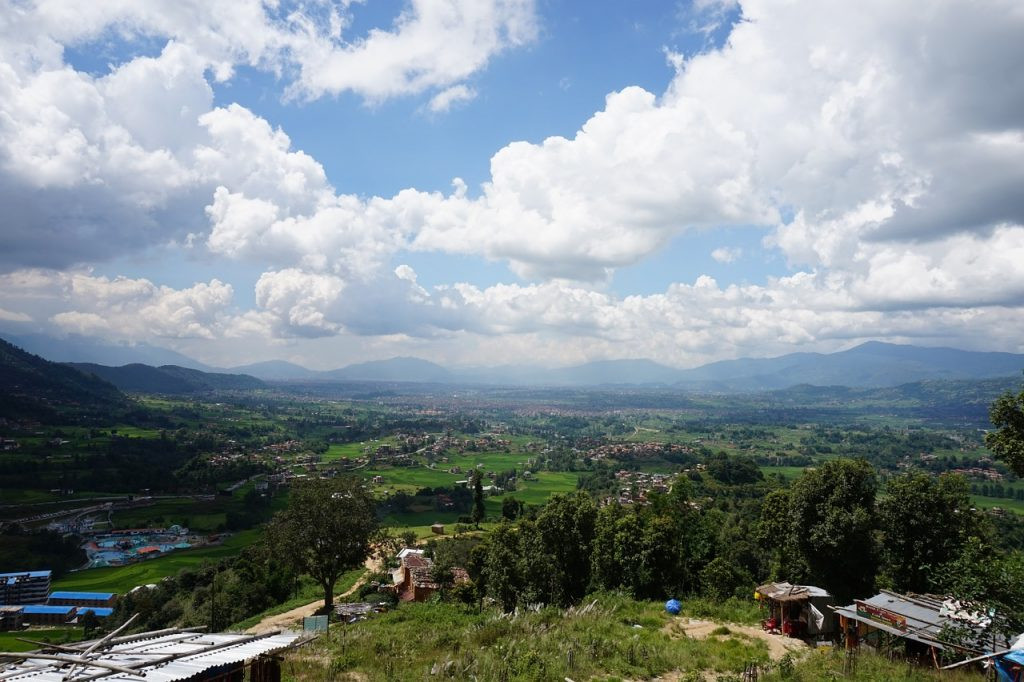 Aerial view of the Kathmandu Valley showcasing the urban sprawl surrounded by green hills.
Aerial view of the Kathmandu Valley showcasing the urban sprawl surrounded by green hills.
Navigating Kathmandu Airport
Tribhuvan International Airport (KTM) serves as Kathmandu’s primary air gateway. Holding the IATA airport code “KTM,” it manages both domestic and international air traffic. Currently, the airport facilitates 9 scheduled domestic routes within Nepal, connecting Kathmandu to various parts of the country, and 35 scheduled international routes, linking Kathmandu to major cities across Asia and beyond. The airport features a single runway capable of accommodating aircraft of all sizes and types, including night landings, ensuring connectivity even during nighttime hours. Direct scheduled flights are readily available from numerous international airports, including Delhi, Kuala Lumpur, Dubai, and Seoul, making Kathmandu accessible from various corners of the globe.
Exploring the Kathmandu Valley
The metropolitan city of Kathmandu sprawls across a wide area with somewhat undefined boundaries. While the city proper is home to approximately 1.5 million residents, the Kathmandu Valley encompasses several other significant cities and towns, including Patan, Bhaktapur, Madhyapur Thimi, Kirtipur, and Lalitpur. The suffix “pur” simply translates to “place” or “town” in Sanskrit and Nepali. In addition to these urban centers, numerous smaller villages dot the valley. Collectively, the Kathmandu Valley houses a population of around 5 million people, making it the most densely populated region in Nepal. The valley itself is characterized by its bowl-like shape, a remnant of an ancient lake that once filled the basin. The land is exceptionally fertile, and coupled with favorable weather patterns, it is ideally suited for agriculture. This agricultural richness likely contributed to the valley’s selection as a population center throughout history.
The Kathmandu Valley boasts a long history of human settlement, potentially spanning thousands of years. Despite its perceived isolation nestled within the Himalayas, the valley has historically been welcoming to visitors from diverse corners of the world. Kathmandu rose to prominence as a vital trading hub during the era of east-west commerce along the Silk Road. The city was strategically positioned on a branch route, facilitating the movement of traders traversing between Tibet and India. Beyond goods, these traders brought with them a rich tapestry of cultures and religions, contributing to Kathmandu’s cosmopolitan character. Modern Kathmandu is renowned for its multi-ethnic composition, fostering an environment of respect and tolerance among its diverse communities. Hinduism is the predominant religion, practiced by approximately 70% of the population, followed by Buddhism at 20%, with the remaining 10% adhering to other faiths, reflecting the valley’s religious harmony.
Kathmandu’s Architectural Marvels
Kathmandu attracts a unique breed of traveler, often drawn by the breathtaking mountain vistas and the allure of distinct cultures. Some seek spiritual enlightenment, for which the region is renowned, while others are captivated by the sheer abundance of ancient monuments, palaces, and temples. Kathmandu is a place where art and religion converge, manifesting in magnificent architectural forms. The profound significance of these ancient sites has been recognized by UNESCO, which has designated seven Monument Zones as World Heritage Sites.
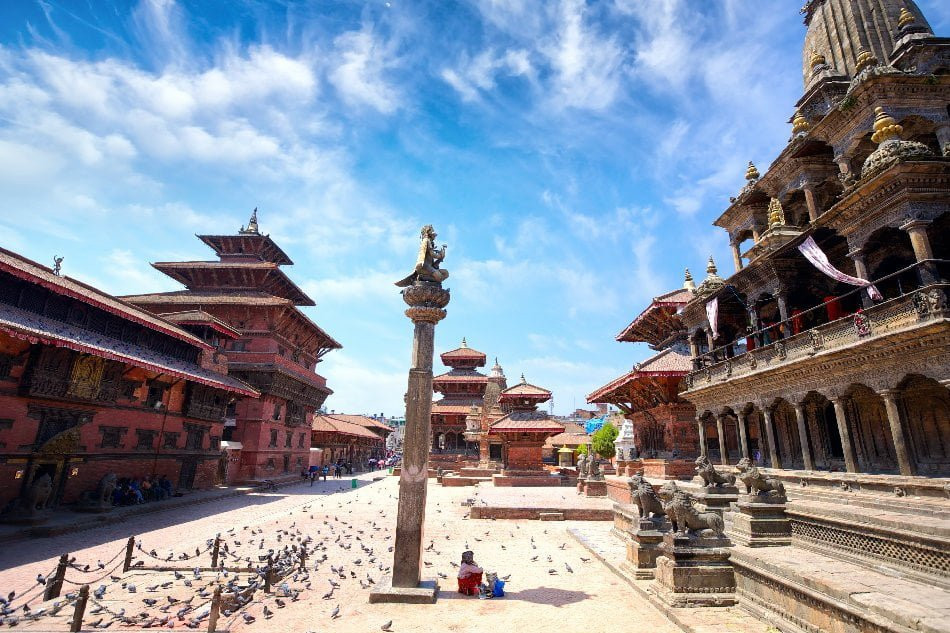 Close-up of Durbar Square in Kathmandu, showcasing intricate wood carvings and pagoda-style temples.
Close-up of Durbar Square in Kathmandu, showcasing intricate wood carvings and pagoda-style temples.
The architectural treasures of Kathmandu extend far beyond these designated zones, which serve as concentrated areas encompassing numerous national treasures. Some of these zones are known as “Durbar Squares,” which literally translates to “Place of Palaces,” reflecting their historical role as royal centers. Others are dedicated to Hindu Temples or Buddhist Stupas (dome-shaped religious monuments). Kathmandu’s Durbar Square, known as Hanuman Dhoka, houses an impressive collection of fifty temples arranged within two quadrangles. Similar Durbar Squares can be found in the satellite towns of Bhaktapur and Patan, each with its unique architectural character.
Some of Kathmandu’s Hindu temples boast remarkable antiquity, with the Changu Narayan Temple dating back to the 4th century and the pagoda-style Pashupatinath Temple originating in the 5th century. The Buddhist stupas, instantly recognizable by their distinctive dome-shaped structure, are prominent features of Kathmandu’s landscape. Boudhanath stands as one of the largest stupas in existence, earning UNESCO World Heritage Site status in 1979. Swayambhu, another frequently visited stupa, holds reverence in both Buddhist and Hindu traditions. Part of Swayambhu’s superstructure, crowning the lower dome, incorporates four representations of Buddha’s eyes, each gazing in a different cardinal direction. This stupa is affectionately known as the Monkey Temple due to its resident population of monkeys.
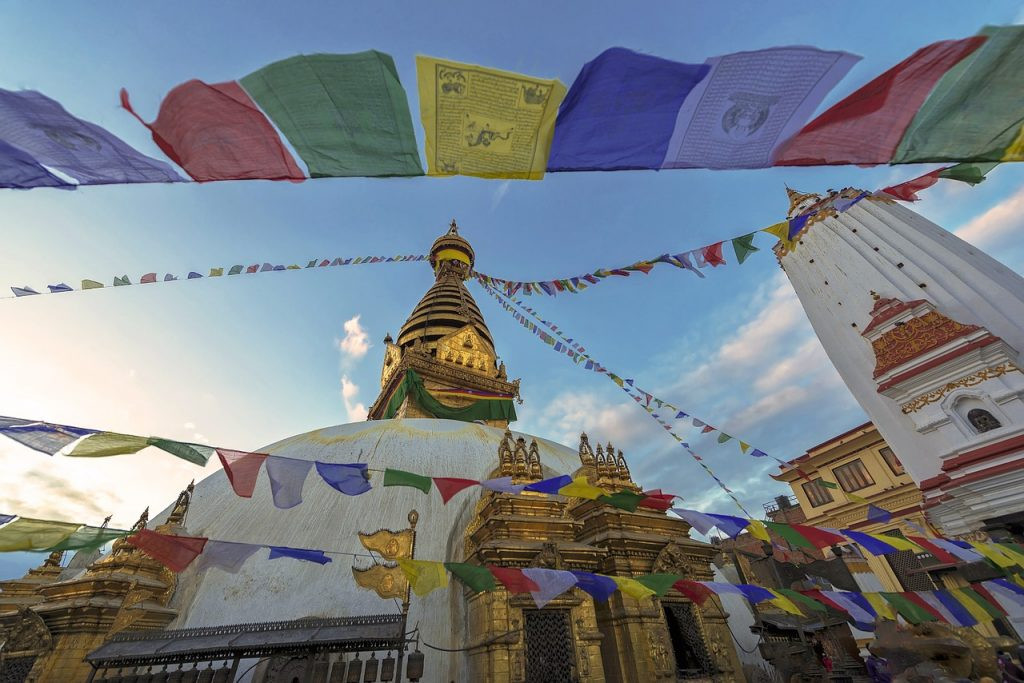 The iconic Buddhist Stupa Swayambhu in Kathmandu, adorned with prayer flags and Buddha eyes.
The iconic Buddhist Stupa Swayambhu in Kathmandu, adorned with prayer flags and Buddha eyes.
Many of Kathmandu’s architectural gems suffered damage in the 2015 earthquake, and some structures were completely destroyed. The Nepalese government has pledged to rebuild all affected monuments, a monumental and complex undertaking expected to span many years before sites like Kathmandu’s Durbar Square are fully restored to their pre-earthquake condition. It’s important to note that the majority of buildings survived the earthquake, and while visitors may encounter ongoing restoration work, the overall character of the area remains largely unchanged. However, the full extent of the damage to Kathmandu’s architectural heritage may not be immediately apparent. Even the official Nepal tourism website tends to downplay the impact, mentioning only the collapse of a few old temples. For a complete picture, the following is a list of buildings confirmed to be completely destroyed in the 2015 earthquake, whose reconstruction represents a significant long-term project:
- Kasthmandap
- Maju Dega and Narayan Vishnu Temples
- Trailokya Mohan
- Krishna (Chasin Dega)
- Dharahara (Bhimsen Tower)
- Hari Shankar
- Jagan Narayan
- Vatsala Durga Temple
- Fasidega Temple
Numerous other buildings sustained damage but were deemed repairable.
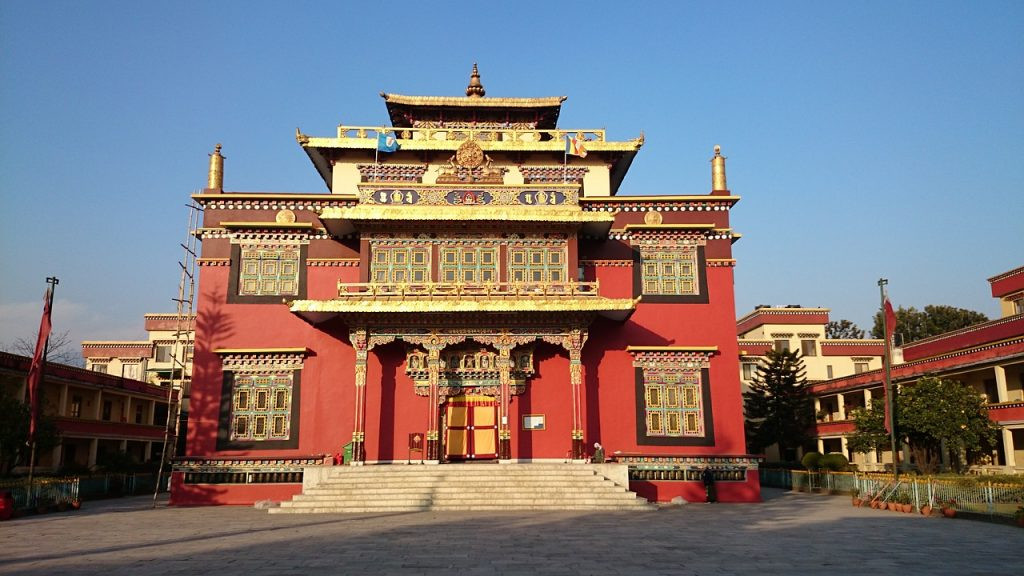 Shechen Tennyi Dargyeling Monastery in Kathmandu, showcasing traditional Tibetan Buddhist architecture.
Shechen Tennyi Dargyeling Monastery in Kathmandu, showcasing traditional Tibetan Buddhist architecture.
Safety in Kathmandu
Despite being a densely populated urban area, Kathmandu is remarkably safe for travelers, particularly in terms of personal crime. It consistently ranks among the safest cities globally, with locals known for their warm hospitality and welcoming nature. The ancient Nepali motto, “Atithi Devo Bhava,” meaning “Guest is equivalent to God,” reflects the deeply ingrained respect for visitors, a sentiment still widely held by Kathmandu residents.
Regarding health, visitors should ensure they are up-to-date on recommended vaccinations, and it is advisable to avoid drinking untreated tap water. Air pollution can be a concern in some of the more congested areas, so individuals with respiratory sensitivities may want to exercise caution in these locations. Earthquake risk is another factor to consider. Being situated in a seismically active zone, tremors are relatively common, but major earthquakes are considered infrequent. Prior to the 2015 earthquake, the last earthquake of similar magnitude struck in 1934. Earthquake-related fatalities and injuries are often caused by collapsing structures or landslides, making it prudent to avoid potentially hazardous locations and to be aware of emergency escape routes in buildings.
Language and Currency in Kathmandu
Kathmandu is a truly cosmopolitan city where a multitude of languages are spoken, with Nepali being the most prevalent. English is also widely understood, particularly in tourist areas, facilitating communication for international visitors. The official currency of Nepal is the Nepalese Rupee (NPR). It’s generally challenging to obtain NPR outside of Nepal, but currency exchange services are readily available at Tribhuvan International Airport upon arrival. However, more favorable exchange rates can often be found within the city itself. Therefore, it is advisable to exchange only a small amount of currency at the airport to cover immediate expenses like taxis or meals and conduct larger currency exchanges later in the city. US dollars are often accepted for smaller transactions and tips, making it useful to carry some US currency as well.
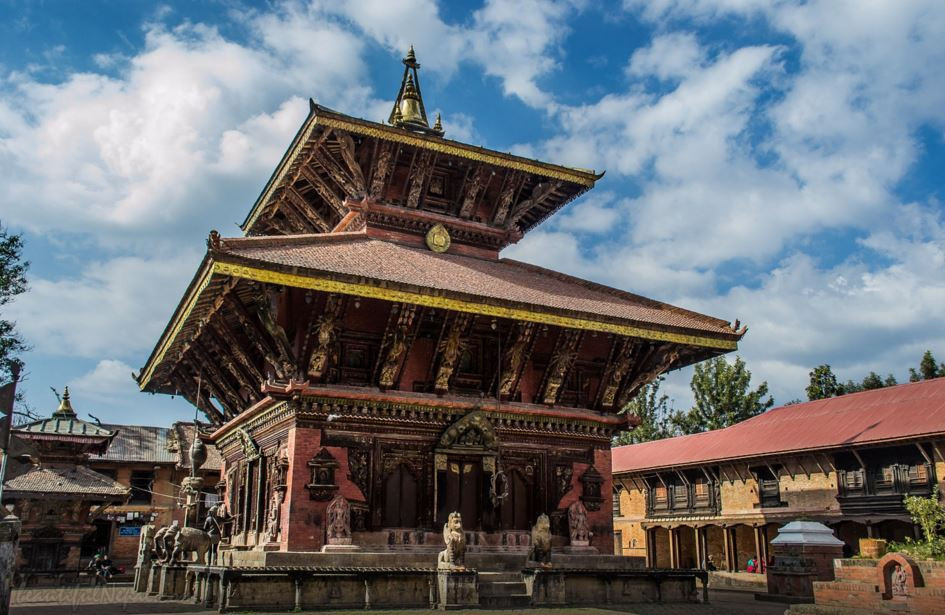 The ancient Changu Narayan Temple in Kathmandu, a UNESCO World Heritage Site.
The ancient Changu Narayan Temple in Kathmandu, a UNESCO World Heritage Site.
Visiting Kathmandu: A Gateway to Adventure
Tourism in Kathmandu began to flourish in the 1950s. However, even before this period, Kathmandu had always been a destination for traders and a significant pilgrimage site for Hindus and Buddhists from across the globe. During the 1960s and 70s, Kathmandu gained popularity among the “hippie” generation and later with independent travelers seeking authentic experiences. Today, Kathmandu is firmly established on the mainstream tourist map, offering accommodations to suit every budget, including luxury hotels like the Hyatt Regency, Hotel Radisson, The Everest Hotel, Hotel De L’Annapurna, and Hotel Yak and Yeti, some of which even feature casinos. More budget-friendly options are also widely available. Beyond the historical sites, popular tourist areas within the city include the whimsically named Freak Street (officially Jhochhen Tol), Thamel, and Jhamel (Jhamsikhel), brimming with shops, hotels, and restaurants. Shopping is a popular activity in Kathmandu, but it’s customary and expected to haggle over prices, as initial prices quoted to tourists are often inflated compared to those for local residents.
Unveiling Things to Do in Kathmandu
Kathmandu is a vibrant and dynamic city with constant activity. Visiting during one of its numerous festivals offers a particularly enriching experience. Most of Kathmandu’s festivals are deeply rooted in religious traditions, dating back centuries, and offer a glimpse into the city’s rich cultural heritage. With an astonishing 133 different festivals celebrated annually, there is always a high probability of witnessing at least one of these remarkable spectacles. A more recent addition to the festival calendar is the Kathmandu Jazz Festival (Jazzmandu), established in 2002, showcasing the influence of Western music in the city.
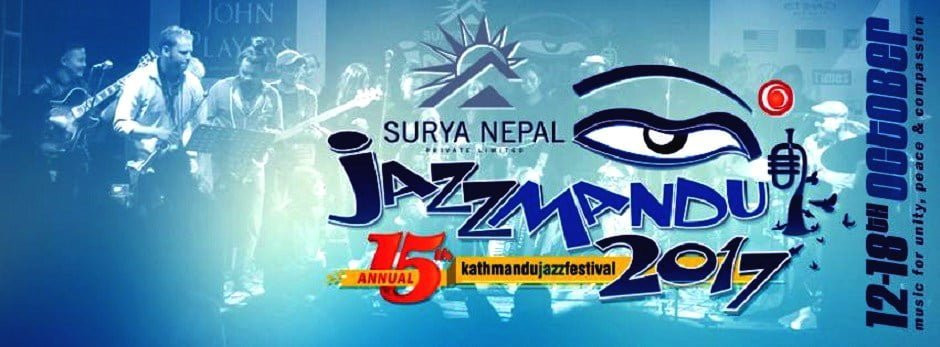 A lively scene from the Kathmandu Jazz Festival (Jazzmandu) with musicians performing outdoors.
A lively scene from the Kathmandu Jazz Festival (Jazzmandu) with musicians performing outdoors.
Many of the goods offered for sale in Kathmandu are exquisite examples of traditional crafts and skills. Visitors can even participate in workshops to learn some of these crafts and create unique souvenirs. Kathmandu is a hub of exceptional artistry and craftsmanship, and it is even credited as the birthplace of the pagoda-style architecture, which later influenced building styles in China. However, what truly distinguishes Kathmandu is its people, renowned for their genuine friendliness. When greeting a Kathmandu resident, a simple gesture of pressing palms together and uttering “Namaste” is enough to forge an instant connection, invariably met with a warm smile and a reciprocal “Namaste.” This Sanskrit greeting translates to “The divine in me bows to the divine in you,” encapsulating the spirit of respect and hospitality that permeates this remarkable city.
The Impact of the 2015 Kathmandu Earthquake
On April 25, 2015, a devastating earthquake struck the Kathmandu region. Measuring 7.8 on the Richter scale, it was among the most destructive earthquakes ever recorded in Nepal. Hundreds of aftershocks followed in the subsequent days, and on May 12, a further significant earthquake of 7.3 magnitude occurred. These earthquakes resulted in tragic loss of life and widespread structural damage, leaving many people homeless and the nation grappling with the long-term consequences of this catastrophe. Media coverage at the time understandably focused on scenes of devastation, leading some to believe that Kathmandu had been entirely flattened. However, this was not the reality. While significant damage occurred, most of Kathmandu remained relatively unscathed. Today, Kathmandu has largely recovered, with life proceeding as usual.
 The aftermath of the 2015 earthquake in Kathmandu, showing damaged buildings and rubble.
The aftermath of the 2015 earthquake in Kathmandu, showing damaged buildings and rubble.
Why Kathmandu is Earthquake-Prone
The frequent occurrence of earthquakes in this mountainous region is not coincidental. They are a result of tectonic activity, specifically the collision of tectonic plates, leading to compression fracturing, known as “faulting.” Kathmandu sits in a zone where the Indian section of the Indo-Australian plate is subducting (sliding beneath) the Eurasian tectonic plate. This process involves a lateral movement of 4-5 cm per year, and the Himalayan mountain range continues to rise by approximately 1 cm annually. This ongoing uplift has given rise to the world’s highest mountain range, but also makes the region susceptible to seismic activity.
Kathmandu is an exhilarating destination that appeals to a multitude of interests – the intellect, the emotions, and the spirit. Despite its modern urban character, visitors discover that they are just moments away from a world seemingly untouched by time. It is a place where history remains interwoven with everyday life… a true Shangri-La, grounded in reality.
